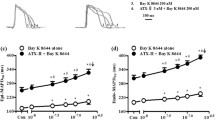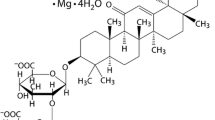Summary
Abnormal enhanced transmural dispersion of repolarization (TDR) plays an important role in the maintaining of the severe ventricular arrhythmias such as torsades de pointes (TDP) which can be induced in long-QT (LQT) syndrome. Taking advantage of an in vitro rabbit model of LQT2, we detected the effects of KN-93, a CaM-dependent kinase (CaMK) II inhibitor on repolarization heterogeneity of ventricular myocardium. Using the monophasic action potential recording technique, the action potentials of epicardium and endocardium were recorded in rabbit cardiac wedge infused with hypokalemic, hypomagnesaemic Tyrode’s solution. At a basic length (BCL) of 2000 ms, LQT2 model was successfully mimicked with the perfusion of 0.5 μmol/L E-4031, QT intervals and the interval from the peak of T wave to the end of T wave (Tp-e) were prolonged, and Tp-e/QT increased. Besides, TDR was increased and the occurrence rate of arrhythmias like EAD, R-on-T extrasystole, and TDP increased under the above condition. Pretreatment with KN-93 (0.5 μmol/L) could inhibit EAD, R-on-T extrasystole, and TDP induced by E-4031 without affecting QT interval, Tp-e, and Tp-e/QT. This study demonstrated KN-93, a CaMKII inhibitor, can inhibit EADs which are the triggers of TDP, resulting in the suppression of TDP induced by LQT2 without affecting TDR.
Similar content being viewed by others
References
Fenichel RR, Malik M, Antzelevitch C, et al. Druginduced torsades de pointes and implications for drug development. J Cardiovasc Electrophysiol, 2004,15(4): 475–495
Curran ME, Splawski I, Timothy KW, et al. A molecular basis for cardiac arrhythmia: HERG mutations cause long QT syndrome. Cell, 1995,80(5):795–803
Yan GX, Wu Y, Liu TX, et al. Phase 2 early afterdepolarization as a trigger of polymorphic ventricular tachycardia in acquired long-QT syndrome: direct evidence from intracellular recordings in the intact left ventricular wall. Circulation, 2001,103(23):2851–2856
Choi BR, Burton F, Salama G. Cytosolic Ca2+ triggers early afterdepolarizations and Torsade de Pointes in rabbit hearts with type 2 long QT syndrome. J Physiol London, 2002,543(2):615–631
Viswanathan PC, Rudy Y. Pause induced early afterdepolarizations in the long QT syndrome: a simulation study. Cardiovasc Res, 1999,42(2):530–542
Marban E, Robinson SW, Wier WG. Mechanisms of arrhythmogenic delayed and early afterdepolarizations in ferret ventricular muscle. J Clin Invest, 1986,78(5): 1185–1192
Anderson ME, Braun AP, Wu Y, et al. KN-93, an inhibitor of multifunctional Ca2+/calmodulin-dependent protein kinase, decreases early afterdepolarizations in rabbit heart. J Pharmacol Exp Ther, 1998,287(3): 996–1006
Lu HR, Vlaminckx E, Van de Water A, et al. Calmodulin antagonist W-7 prevents sparfloxacin-induced early afterdepolarizations (EADs) in isolated rabbit purkinje fibers: importance of beat-to-beat instability of the repolarization. J Cardiovasc Electrophysiol, 2006,17(4): 415–422
Quan XQ, Bai R, Liu N, et al. Increasing gap junction coupling reduces transmural dispersion of repolarization and prevents torsade de pointes in rabbit LQT3 model. J Cardiovasc Electrophysiol, 2007,18(11):1184–1189
Quan XQ, Bai R, Lu JG, et al. Pharmacological enhancement of cardiac gap junction coupling prevents arrhythmias in canine LQT2 model. Cell Commun Adhes, 2009,16(1–3):29–38
Liu T, Brown BS, Wu Y, et al. Blinded validation of the isolated arterially perfused rabbit ventricular wedge in preclinical assessment of drug-induced proarrhythmias. Heart Rhythm, 2006,3(8):948–956
Viitasalo M, Oikarinen L, Swan H, et al. Ambulatory electrocardiographic evidence of transmural dispersion of repolarization in patients with long-QT syndrome type 1 and 2. Circulation, 2002,106(19):2473–2478
Yan GX, Antzelevitch C. Cellular basis for the normal T wave and the electrocardiographic manifestations of the long-QT syndrome. Circulation, 1998,98(18):1928–1936
Yamaguchi M, Shimizu M, Ino H, et al. T wave peak-to-end interval and QT dispersion in acquired long QT syndrome: a new index for arrhythmogenicity. Clin Sci (Lond), 2003,105(6):671–676
Takenaka K, Ai T, Shimizu W, et al. Exercise stress test amplifies genotype-phenotype correlation in the LQT1 and LQT2 forms of the long-QT syndrome. Circulation, 2003,107(6):838–844
Wu Y, Temple J, Zhang R, et al. Calmodulin kinase II and arrhythmias in a mouse model of cardiac hypertrophy. Circulation, 2002,106(10):1288–1293
Ke J, Zhang CT, Ma YX, et al. The effects of calmodulin kinase II inhibitor on ventricular arrhythmias in rabbits with cardiac hypertrophy. Zhonghua Xin Xue Guan Bing Za Zhi (Chinese), 2007,35(1):33–36
Hlaing T, DiMino T, Kowey PR, et al. ECG repolarization waves: their genesis and clinical implications. Ann Noninvasive Electrocardiol, 2005,10(2):211–223
Wu Y, MacMillan LB, McNeill RB, et al. CaM kinase augments cardiac L-type Ca2+ current: a cellular mechanism for long Q-T arrhythmias. Am J Physiol, 1999,276(6):H2168–H2178
Dzhura I, Wu Y, Colbran RJ, et al. Calmodulin kinase determines calcium-dependent facilitation of L-type calcium channels. Nat Cell Biol, 2000,2(3):173–177
Wu Y, Roden DM, Anderson ME. Calmodulin kinase inhibition prevents development of the arrhythmogenic transient inward current. Circ Res, 1999,84(8):906–912
Meyer T, Hanson PI, Stryer L, et al. Calmodulin trapping by calcium-calmodulin-dependent protein kinase. Science, 1992,256(5060):1199–1202
De Ferrari GM, Viola MC, D’Amato E, et al. Distinct patterns of calcium transients during early and delayed afterdepolarizations induced by isoproterenol in ventricular myocytes. Circulation, 1995,91(10):2510–2515
Xiao RP, Cheng H, Lederer WJ, et al. Dual regulation of Ca2+/calmodulin-dependent kinase II activity by membrane voltage and by calcium influx. Proc Natl Acad Sci USA, 1994,91(20):9659–9663
Yuan W, Bers DM. Ca-dependent facilitation of cardiac Ca current is due to Ca-calmodulin-dependent protein kinase. Am J Physiol, 1994,267(3):H982–H993
Author information
Authors and Affiliations
Corresponding author
Additional information
The authors contributed equally to this work.
This project was supported by Natural Science Foundation of Hubei Province, China (No. 2008CDB163).
Rights and permissions
About this article
Cite this article
Wang, Wl., Zhang, Ss., Deng, J. et al. KN-93, A CaMKII inhibitor, suppresses ventricular arrhythmia induced by LQT2 without decreasing TDR. J. Huazhong Univ. Sci. Technol. [Med. Sci.] 33, 636–639 (2013). https://doi.org/10.1007/s11596-013-1172-1
Received:
Revised:
Published:
Issue Date:
DOI: https://doi.org/10.1007/s11596-013-1172-1




